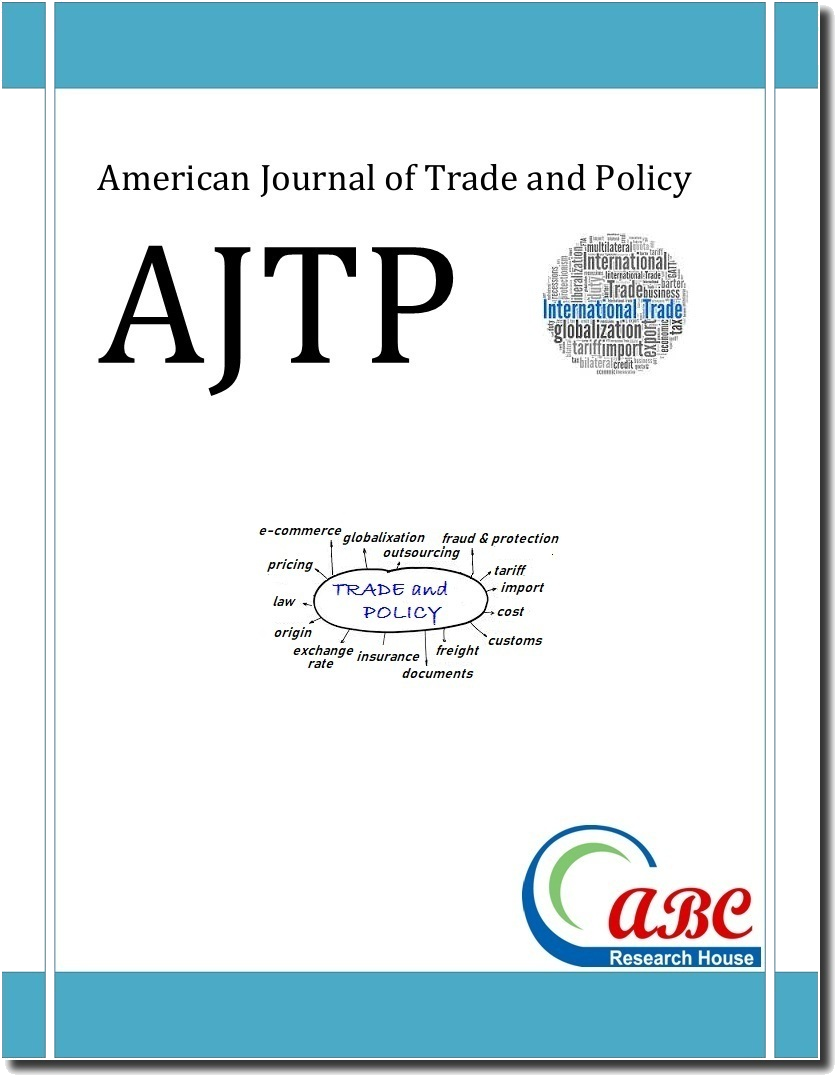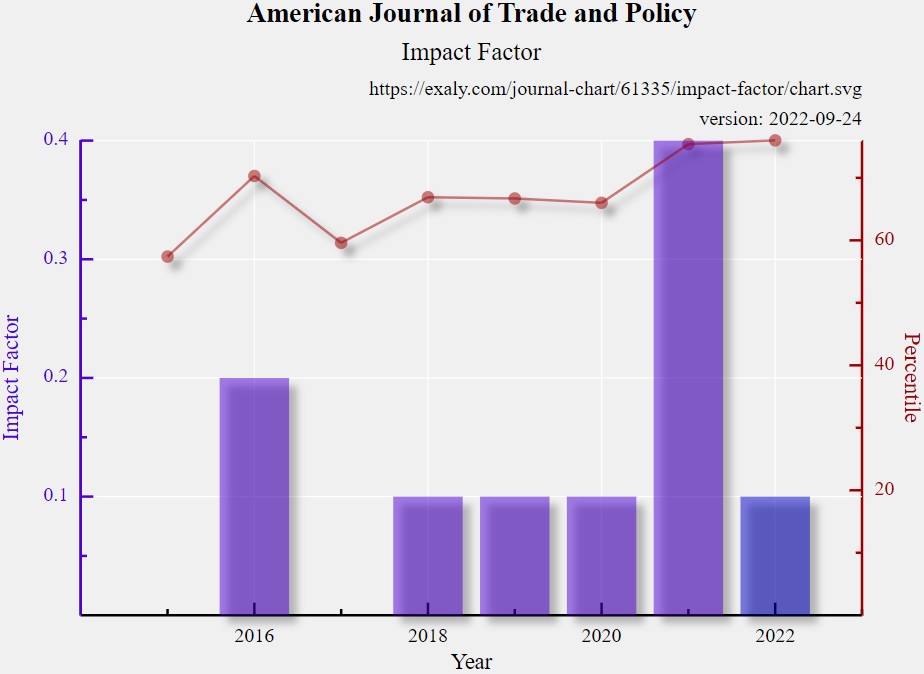Unveiling the Potential of PPP Theory: A Practical Approach to Short-Term BDT-USD Exchange Rate Forecasting in Bangladesh
DOI:
https://doi.org/10.18034/ajtp.v11i1.746Keywords:
Purchasing Power Parity (PPP), Exchange Rate Forecasting, BDT-USD Exchange Rate, Inflation Differential, Short-Term Currency Prediction, Statistical Modeling in FinanceAbstract
This study explores the viability of the PPP (Purchasing Power Parity) theory in predicting short-term exchange rate movements in Bangladesh. We aim to construct a forecast model, exclusively based on PPP theory, to accurately estimate the 30, 60, and 90-day forward exchange rates of BDT-USD (Bangladeshi Taka - US Dollar) with minimal error. Drawing from approximately 9 years of monthly data, we utilize monthly nominal CPI values from Bangladesh and the USA to compute six inflation differentials across various periods (30, 60, 90, 120, 150, and 180 days). To determine the lagged impact of inflation on exchange rates, we employ a straightforward correlation matrix with associated p-values. Among these sets, the one exhibiting the highest correlation (along with the lowest p-value) with the percentage change in the 30-day forward rate is identified as the very variable having the highest impact on the next 30-day forward rate. This process is repeated for the 60 and 90-day forward rates, leading to three distinct equations for forecasting each duration. Finally, error-adjustment variables are incorporated in these equations. Our model relies on five readily available data points to forecast forward exchange rates. Results indicate that this model accurately forecasts the 30-day forward exchange rate with a ±0.58% error margin and 98.84% accuracy, with statistical robustness at a 5% significance level across the sample period. However, the performance diminishes when forecasting 60 and 90-day forward exchange rates. This study underscores the effectiveness of PPP theory in predicting up to 30 days of forward exchange rates in Bangladesh, highlighting its practical applicability in economics and finance.
Downloads
References
Ahmed, S. (2012). Explaining inflation in Bangladesh: The Financial Express, Dhaka, Monday, July 9, 2012. http://www.thefinancialexpress-bd.com/old/more.php?page=detail_news&date=2012-07-09&news_id=135857
Allsopp, C., Kara, A., & Nelson, E. (2006). U.K. Inflation Targeting and the Exchange Rate: FRB of St. Louis Working Paper No. 2006-030A. http://ssrn.com/abstract=900132
Antweiler, W. (2011). Purchasing Power Parity: The Pacific Exchange Rate Service. http://fx.sauder.ubc.ca/PPP.html
Apte, P., Sercu, P., & Uppal, R. (2002). The Exchange Rate and Purchasing Power Parity: Extending the Theory and Tests: CEPR Discussion Paper No. 3343. http://ssrn.com/abstract=315019
Ball, C. P., & Reyes, J. A. (2012). Remittances, Inflation and Exchange Rate Regimes in Small Open Economies. http://ssrn.com/abstract=1119318
Bask, M. (2006). Exchange Rate Volatility without the Contrivance of Fundamentals and the Failure of PPP: Bank of Finland Research Discussion Paper No. 8/2006. http://ssrn.com/abstract=1018331
Clarida, R., & Waldman, D. (2007). Is Bad News About Inflation Good News for the Exchange Rate? : NBER Working Paper No. w13010. http://ssrn.com/abstract=913306
Fayad, C., Fortich, R., & Velez-Pareja, I. (2009). Forecasting Foreign Exchange Rate Assuming PPP Conditions: Empirical Evidence Using VAR: Estudios Gerenciales. Journal of Management and Economics of Iberoamerica, Vol. 25, No. 113, pp. 211-226, October-December 2009. http://ssrn.com/abstract=1401538
Hargreaves, D., & Brook, A.-M. (2001). PPP-Based Analysis of New Zealand's Equilibrium Exchange Rate: Reserve Bank of New Zealand Discussion Paper No. DP2001/01. http://ssrn.com/abstract=320296
Hasanuzzaman, M. (2012). Trend about exchange rate of Bangladesh Taka: The Financial Express, February 11, 2012. http://www.thefinancialexpress-bd.com/more.php?date=2012-02-11&news_id=97989
Hossain, A. (2002). Exchange Rate Responses to Inflation in Bangladesh. http://ssrn.com/abstract=880195
Hossain, M. (2009). Exchange rate management in Bangladesh: An assessment: The Financial Express, August 29, 2009. http://www.thefinancialexpress-bd.com/2009/08/29/77461.html
Hossain, M., & Ahmed, M. (2009). Exchange rate policy under floating regime in Bangladesh: An assessment and strategic policy options: BIDS-PRP Working Paper Series Working Paper No. 2 http://mpra.ub.uni-muenchen.de/20487/1/PRP_WP2_Ex_Rate_in_Bangladesh.pdf
Investopedia. (2013). Purchasing Power Parity - PPP: Investopedia US. http://www.investopedia.com/terms/p/ppp.asp
Kamin, S. B. (1997). A Multi-Country Comparison of the Linkages Between Inflation and Exchange Rate Competitiveness: BIS Working Paper No. 45. http://ssrn.com/abstract=860684
Madura, J. (2006). International Financial Management (8 ed.): Thomson South-Wrstrrn.
Nguyen, J. (2011). 4 Ways To Forecast Currency Changes: investopedia.com. http://www.investopedia.com/articles/forex/11/4-ways-to-forecast-exchange-rates.asp
Qayyum, A., Arshad, & Zaman, K. U.-. (2004). Exchange Rate Misalignment in Pakistan: Evidence from Purchasing Power Parity Theory: Pakistan Development Review, Vol. 43, No. 4, Winter 2004. http://ssrn.com/abstract=966106
Sayal, M. (2004). Detecting Time Correlations in Time-Series Data Streams: Hewlett-Packard. http://www.hpl.hp.com/techreports/2004/HPL-2004-103.pdf
Schnabl, G., & Grauwe, P. D. (2006). Exchange Rate Stability, Inflation and Growth in (South) Eastern and Central Europe: Review of Development Economics, (Forthcoming). http://ssrn.com/abstract=946968
Suthar, M. H. (2008). Determinants of Exchange Rate in India. http://ssrn.com/abstract=1165602
Taylor, A. M., & Taylor, M. P. (2004). The Purchasing Power Parity Debate: Journal of Economic Perspectives—Volume 18, Number 4—Fall 2004—Pages 135–158. http://www.ssc.wisc.edu/~mchinn/taylor&taylor_PPP_JEP.pdf
Taylor, M. P., & Sarno, L. (2001). Purchasing Power Parity and the Real Exchange Rate: CEPR Discussion Paper No. 2913. http://ssrn.com/abstract=280902
The World Bank. (2012). Global Economic Monitor: The World Bank Group. http://data.worldbank.org/data-catalog/global-economic-monitor
Tsurumi, H., & Chen, C. L. (1998). Testing the Purchasing Power Parity Theory: A Case of the Taiwanese Dollar Exchange Rate: Journal of Economic Integration, Vol. 13, No. 2, June 1998. http://ssrn.com/abstract=108368
Younus, S., & Chowdhury, M. I. (2006). An Analysis of Bangladesh’s Transition to Flexible Exchange Rate Regime: Bangladesh Bank, Working Paper Series No: WP 0706. http://www.bangladesh-bank.org/pub/research/workingpaper/wp0706.pdf
Zanna, L.-F. (2009). PPP Exchange Rate Rules, Macroeconomic (In)Stability, and Learning: International Economic Review, Vol. 50, No. 4, pp. 1103–1128, November 2009. http://ssrn.com/abstract=1495269
Downloads
Published
Issue
Section
License
Copyright (c) 2024 Shahed Ahmmed; Shati Sarmin Rahman

This work is licensed under a Creative Commons Attribution-NonCommercial 4.0 International License.
American Journal of Trade and Policy is an Open Access journal. Authors who publish with this journal agree to the following terms:
- Authors retain copyright and grant the journal the right of first publication with the work simultaneously licensed under a CC BY-NC 4.0 International License that allows others to share the work with an acknowledgment of the work's authorship and initial publication in this journal.
- Authors are able to enter into separate, additional contractual arrangements for the non-exclusive distribution of the journal's published version of their work (e.g., post it to an institutional repository or publish it in a book), with an acknowledgment of its initial publication in this journal. We require authors to inform us of any instances of re-publication.














